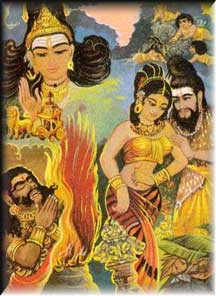 |

|
|
HINDU DEMON - ASURA
SUPREME DEITY
Demons, rivals and enemies of Sakra Devendra (Indra) and
the Devas (Gods) with whom they are constantly at war. The
Asuras dwell in the oceans (the atmospheres, the realms of
turbulence) whereas the gods (Devas) dwell in the serene
palaces of heaven.
Asura literally means ‘one without the ambrosia of heaven
(soma)’ - that is, they are restless, without the bliss, joy
and contentment of heaven - they must ever struggle in the
realms of strife and turbulence. They appear in many forms,
including Nagas (water spirits), Yakshas (earth spirits),
Daityas (genies), Dasyus (barbarians), Kalakanjas (stellar
spirits), Kalejas (demons of time), Khalins (threshers),
Nivata-kavacas (wearers of armor), Pisacas (flesh eaters),
Raksasas (night wanderers) and a host of others forms. There
are four classes, according to their manner of their
rebirth: no.1 egg-born no 2 womb-born no 3 metamorphosis
born no 4 water/spawn born. They are the competitive forces
of nature that are forever battling for dominance over one
another. In human nature they represent the assertion &
clash of rival egos. In Hindu belief, an asura ('breath,' or even 'not god')
is a divinity. In the oldest part of the Rig-Veda the word
is tantamount to 'Supreme Deity,' just as Ahura is the god
of the Zoroastrians.
Later asura came to mean not divinity but demon and the
Brahmans speak of contests between the wicked asuras and the
good gods. |

WORLD RELIGIONS
COMPARED
WORLD
RELIGIONS CLIPART
WORLD
RELIGIONS HOME
HINDUISM HOME
HINDU SPIRIT WORLD
HINDU DEMONS |
Azuras came, it is said, from the breath of Pajapati (or
from his belly when he became pregnant), who was the origin
of 'gods, men, fathers, Gandharvas, and Apsarases' from
water; the bad creatures may be from drops of water spilled.
Likewise we may more or less accidentally have got the
Rakshasas and Pisachas.
Manu, father of men, says the asuras derive from 'Prajapati's
groin.' Vishnu Purana says they came from the groin of
Brahma.
The origins of these evil creatures is debated. In any case,
asuras now is a term that covers 'the enemies of the gods,
including the Rakhasas descended from Pulastya.'
Let us start with Kasyapa. He was a Vedic sage who did much
creation, both of hymns and creatures. Grandson of Brahma,
father of Vishnu, grandfather of Manu, the progenitor of all
mankind. That's Kasyapa. By Diti, Kasyapa gave birth to the
Daityas, unpleasant demons who were kratudwishas (spoilers
of sacrifices); they had to be defeated by the good gods.
These Daityas are hardly distinguishable from other
creatures fathered by Kasyapa, called Danavas, also demons.
Then there are Darbas (Tearers), destructive demons.
And Rakshasas (Guardians), descended from either the sage Pulastya
or (in another story) from the foot of Brahma. These Rakshasas are
goblins and ghouls. They can be titans or smaller but they all haunt
cemeteries, disturb sacrifices, animate corpses, devour people,
harass the devout, and spread disease and disorder. Some scholars
have suggested that they represent the barbarian peoples whom the
Aryans first encountered, then defeated.
The Hindus have many devils and demons and, as with
the Judeo-Christian tradition, there are questions about their
origins but a common explanation is that they were first good and
later bad (like the fallen angels).
Those who are asuras,
they do not know what kind of action should be done
and what kind of action should not be done.
Bhagavad-Gita

| |
 |
 |